
FOR this FNY Crosstown post I selected 4th Street, which is the only numbered east-west street (that always had a number) to almost go river to river south of 13th Street. I say “almost” since West 4th stops short of the Hudson by about 4 blocks, and East 4th is stopped by the Jacob Riis Houses at Avenue D from proceeding on to the East River.
4th Street didn’t always used to be nearly all the way crosstown. The portion west of 6th Avenue that runs through Greenwich Village used to be called Asylum Street. West 4th turns northwest at 6th Avenue and intersects 10th, 11th, 12th and 13th. The short story is that in the early 19th Century the Orphan Asylum Society stood on the street between Bank and Troy (12th) and the street that went past it was called called Asylum Street, and when the asylum was torn down in 1833, the city decided to make it a western extension of West 4th, creating illogical intersections when the other named streets also acquired numbers. Asylum Street had been previously renamed in 1813 from William Street, possibly to avoid redundancy with the William Street downtown.
Bob Dylan’s 1965 putdown hit, “Positively 4th Street” came out the same year as his LP named for another route, “Highway 61 Revisited.” It has never been “positively” cleared up, by Bob himself or anyone else, what 4th Street is in the title. It could be this 4th Street or it could be the one in Minneapolis, where he also spent a chunk of time.
To save myself time and sanity, I’ll have to split up my coverage of 4th Street into several posts, 2 or 3, probably. I’ll confine myself today to the section of West 4th that runs from 6th Avenue east to Broadway, incorporating Washington Square South.
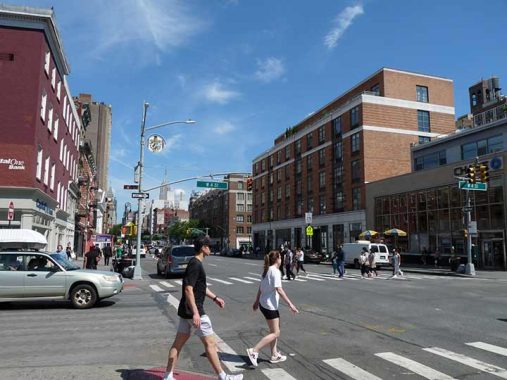
It’s hard to imagine this now but before 1928 or thereabouts 6th Avenue was rather narrower and was completely shadowed by an elevated train, the 6th Avenue El. When the IND 6th Avenue line was constructed under the avenue in the late 1930s, it was widened somewhat, which ironically made it automobile magnet. I’m not sure when it was rendered one-way uptown, but it was sometime in the 1960s.
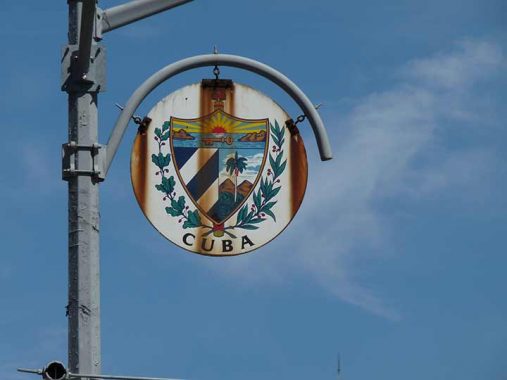
I never get tired of pointing out 6th Avenue’s remaining Medallions of the Hemisphere, metal signs depicting member countries of the Organization of American States in North, South and Central America. Cuba was kicked out in 1962 but reinstated in 2009, and its medallion can still be seen at 6th Avenue and West 4th.
Cuba is the most westerly of the West Indies islands and is about 90 miles south of Florida. The island was ‘discovered’ by Columbus, sailing for the Spanish flag, in 1492. He found a tribe of Indians called the Ciboney; by 1600, the tribe was virtually extinct.
Beginning in the mid-1800s, Cubans engaged in two wars of independence against Spain. After the Spanish-American War the USA installed a governor but relinquished power to an elected Cuban government in 1902. In 1933, Fulgencio Batista took power in a coup and held it until 1959, when a guerrilla campaign led by a young lawyer named Fidel Castro overthrew him. The Soviet Union and the USA went ‘eyeball to eyeball’ over the presence of long range nuclear missiles there in 1962.
Cuba’s national coat of arms is shaped like a pointed shield and divided into three sections: in its horizontal upper part, there is a golden key between two mountains, and a sun rising over the sea symbolizing the position of Cuba between the two Americas, amidst the emergence of a new state. The blue and white stripes down the left hand side represent Cuba’s colonial period; down the right hand side, a Cuban country scene is dominated by a palm tree, meant to represent the character of the Cuban people.
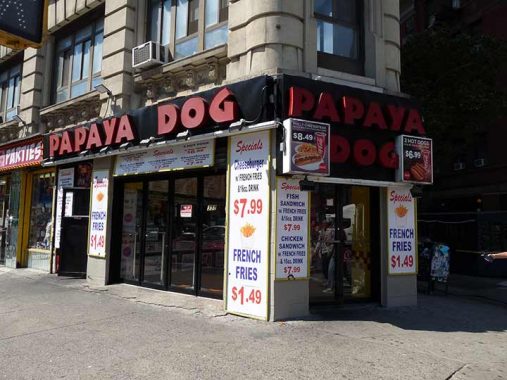
Papaya Dog, on the SW corner of 6th and West 4th, is among a number of hot dog and papaya juice joints scattered around town. Unfortunately, October 2021 marked the closure of the Papaya Dog at 1st Avenue and East 14th at Stuyvesant Town. The original, or at least the oldest in the batch, still holds forth at 3rd Avenue and East 86th. It was opened by Greek immigrant Gus Poulos as Hawaiian Tropical Drinks there in 1932. How did hot dogs get involved? The story goes that this was still a German stronghold (the heart of Yorkville) at the time and the locals requested hot dogs or perhaps bratwurst or knockwurst as accompaniment.
There was much weeping and teeth gnashing when Gray’s Papaya shut down in 2014 but it was only a couple of blocks away on West 8th Street. Papaya King, on 7th Avenue and West 14th, had shut down in 2009. When I worked for 9 months in the Tiffany & Co. offices at 201 5th Avenue at Madison Square, I was undoubtedly the only person working there who would have an occasional lunch at Chelsea Papaya on 7th Avenue and West 23rd.
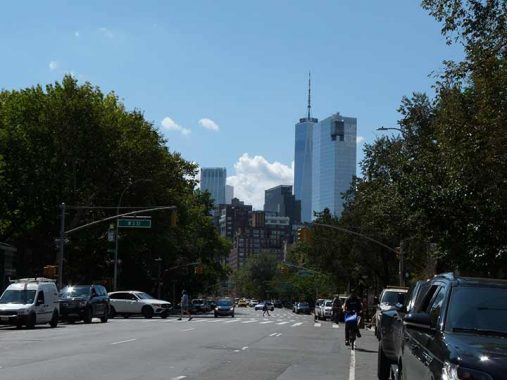
For 30 years between 1971-2001 the view south on 6th Avenue provided a view of the twin towers of the first World Trade Center. For a few years, the taller single tower One WTC had an unobstructed view, but it’s being joined by a thicket of other glass towers.
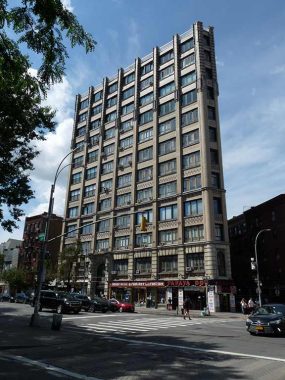
#333 6th Avenue, which houses the Papaya Dog as well as fetish costume and tattoo joints, 99 cent pizza and a Weed World, is a 12 story loft built as the Varitype Building in 1907. It’s an attractive building with interesting brickwork. The lot it’s on, defined by 6th Avenue, West 4th and Cornelia Street, gives it an uneven shape.
This vest pocket garden at Sixth and West 4th commemorates the Golden Swan Cafe, also known as The Hell Hole, a sawdust-floored dive with a weather-beaten stuffed swan in the back room. Who was drinking at the bar? Eugene O’Neill was a regular patron in the mid-1910s, getting ideas for plays like The Iceman Cometh. The Hell Hole was demolished in 1928.
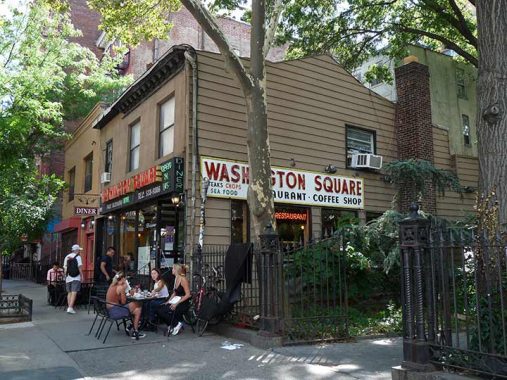
It’s odd how I recall drinking at Jimmy Day’s on West 4th and Barrow in my postcollegiate era (see Part 1 linked above) but I must have been in the Washington Square Coffee Shop at least once or twice but don’t remember. The buildings from #146-150 West 4th were home to long-ago Village haunts The Pepper Pot, the Samovar and the Mad Hatter, which had a sign at the front entrance, NWOD EHT TIBBAR ELOH, which you were supposed to read backwards.
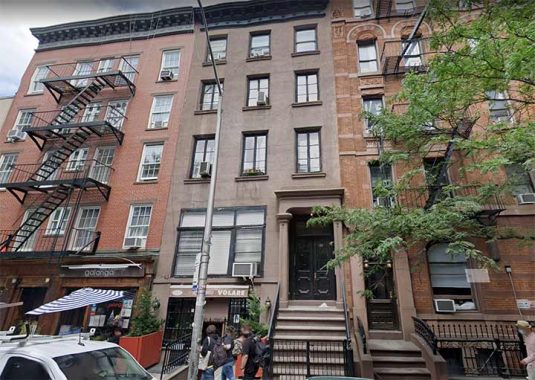
The center building, #147 West 4th, has hosted Ristorante Volare for over 3 decades. The building was constructed in 1848 and has seen a lot of history. In the 18th Century, Evening Post editor and poet William Cullen Bryant resided here, and some decades later, journalist/activist John Reed (“10 Days That Shook The World” on the Russian Revolution; he was played by Warren Beatty in Reds.) This was also home to a precursor of the Whitney Museum, today a mile or so west at Gansevoort and Washington Streets.
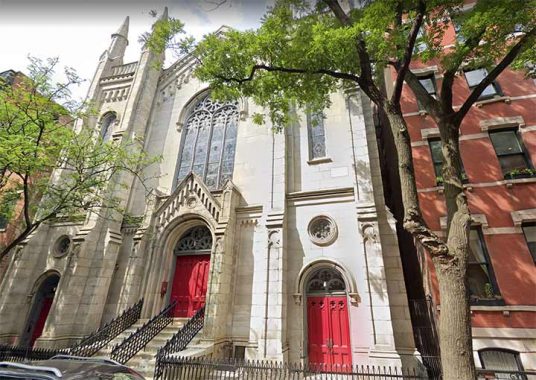
This building at #135 West 4th was the Washington Square Methodist Episcopal Church from its construction in 1860 through 2004 when its remaining congregation sold the building. Pastor Finley Schaef was famed for opposing the Vietnam War in the 1960s and the WSMEC’s pastor from 1973-1984, Paul Abels, was NYC’s first openly gay churchman. Today the building hosts condominiums.
Next door is #133, the former church parsonage, or pastor’s house, built in 1879 and later altered.
I have always been partial to the 16-story brick apartment tower #37 Washington Square West, mainly because of its extensive color terra cotta escutcheons and its mighty front entrance overhead canopy. Oddly the Greenwich Village Landmarks Preservation report does not give a date of construction.
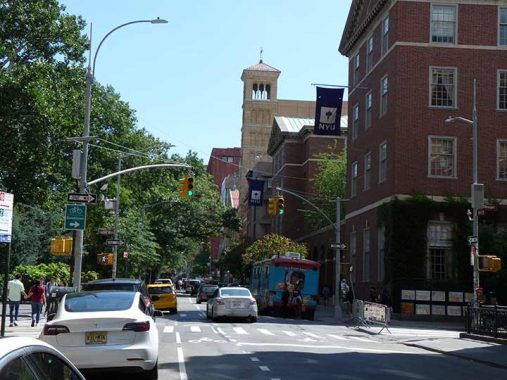
West 4th Street looking east from Macdougal. Bordering Washington Square Park, West 4th becomes Washington Square South and there are some anomalies. While house numbering on West 4th proceeds east to west from Broadway, Washington Square South’s house numbering begins here, at #40, and proceeds east with both odds and evens on the south side until reaching #70 at Washington Square East. That’s because house numbering around Washington Square begins with #1 at Washington Square North and University Place, runs west to Washington Square West and Waverly Place, runs south to West 4th, then east along Washington Square South and then north along Washington Square East!
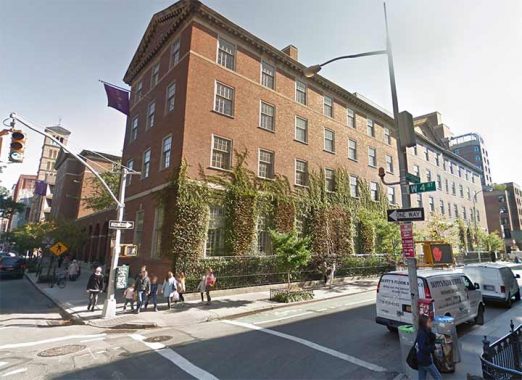
Vanderbilt Hall, #40 West 4th at Macdougal, which houses New York University’s law school, was completed in 1951 and looks older than that: it was built during an era when architects and developers still often strived to create contextual architecture that attempted to fit in with its neighbors. Nevertheless, during its development there was a considerable effort to derail it because several older buildings on West 4th and Macdougal were demolished to make way for it including former residences of authors and playwrights Willa Cather, Theodore Dreiser, Eugene O’Neill, for which it was known as “Genius Row.”
While many buildings in New York are named Vanderbilt, most are named for transportation and real estate magnate Cornelius Vanderbilt. However, Vanderbilt Hall was named for New Jersey State Supreme Court Justice Arthur T. Vanderbilt.
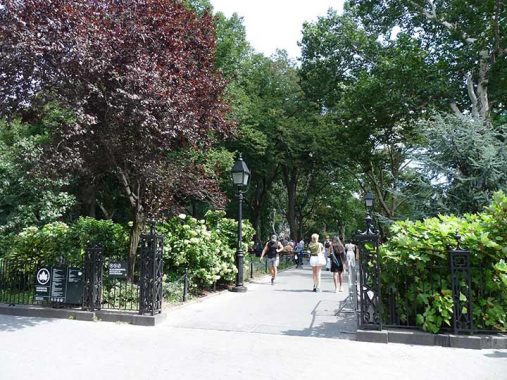
The history of Washington Square in NYC is long and varied; it was first a marshy area surrounding Minetta Brook, which ran from Midtown southwest to the Hudson River), then a cemetery (1797; a tombstone dated 1799 was actually found during the excavation process during renovations) a parade ground for military marching drills (1826); and finally, a public park (1827). I discuss the park on this FNY page.
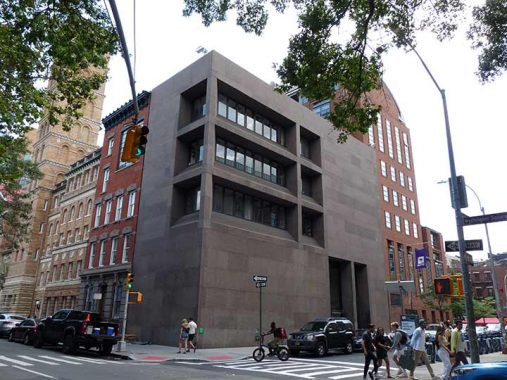
Speaking of noncontextual architecture, here’s #50 Washington Square South, NYU’s Hagop Kevorkian Center for Near Eastern Studies, the only building on Washington Square South east of Sullivan Street included in the South Village Historic District. That’s likely because it was co-designed by architecture giant Philip Johnson and completed in 1972, when Brutalism was in full “flower.” FNY readers know I’m not a fan of the genre, but it does have its proponents.
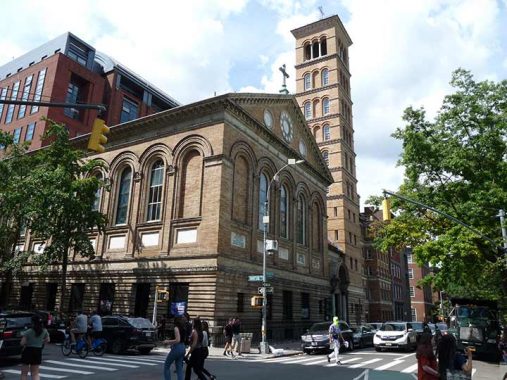
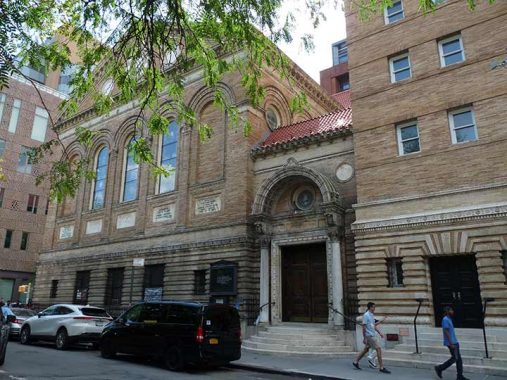
For well over a century the campanile of Judson Memorial Church, at Washington Square South and LaGuardia Place has dominated the view south from Washington Square. The church is also the work of architect Stanford White, and features stained glass by John LaFarge and sculpture by Augustus St. Gaudens, and went up in 1896; it was designated a NYC landmark in 1966. Adoniram Judson was the first American baptist missionary in Asia, working primarily in Burma. Like a lot of property in the area, most of the complex now belongs to New York University.
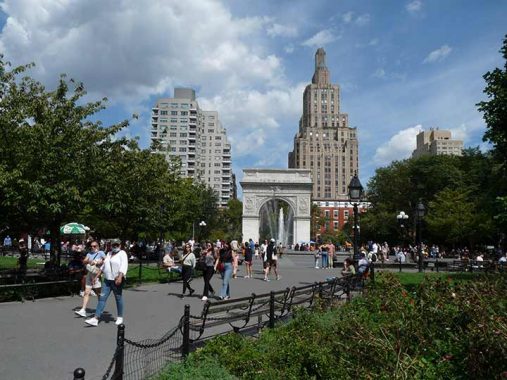
The view of the Square north from Washington Square South and Thompson Street looking north past the fountain (which was installed in 1872, replacing an earlier one from 1852), to Stanford White’s memorial George Washington Arch (1892).
If roads czar Robert Moses had got his wish, the circle around the fountain, which was once used to turn 5th Avenue buses and was open to motor traffic when the Queen of Avenues was one-way, and the fountain would be moved to make way for a connector road between 5th Avenue and LaGuardia Place. Locals fought Moses tooth and nail (as they did against his proposed Lower Manhattan Expressway on Broome Street) and after a lot of vitriol, the Master Builder backed down. However, the fountain was moved anyway between 2007-2011, but not without a hue and cry I mostly failed to understand.
White, therefore, has monuments at both the north and south ends of the park, the Judson Memorial Church and the arch. When ground was being cleared for the arch, human remains were found underground, a reminder that Washington Square had once been a potter’s field. In the rear we can see the “supertalls” of the early to mid 20th Century, #2 (left, 1951, Emery Roth) and #1 5th Avenue (1926, Helmle & Corbett and Sugarman & Berger). The restaurant One Fifth was used frequently employed for TV and movie scenes (I was a patron occasionally) and was run by the same restaurateurs who now own Odeon, another restaurant seen on the big screen.
NYU’s Catholic Center, #58 Washington Square South at Thompson Street, was built from 2010-2011 and also includes a nondenominational spiritual center. Previous occupants of the site were the residence of the gravedigger of the potter’s field upon which Washington Square now occupies and a boarding house/restaurant run by Grace Godwin, who forbade African Americans to patronize it.
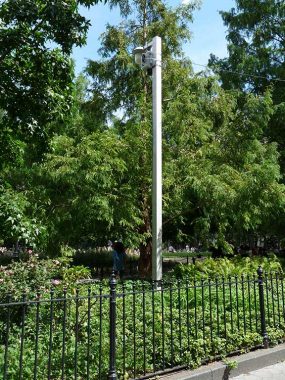
This L-shaped lamp is of a “species” formerly used throughout Washington Square, but this seems to be the last Mohican; they were replaced by post-top faux gaslamps throughout the park several years later.
The somewhat forbidding-looking Elmer Holmes Bobst Library filling the block between West 3rd and 4th and LaGuardia Place is clad in red sandstone with a minimum of windows. It opened in 1973, designed by famed architect Philip Johnson, with an $11M grant from philanthropist Bobst, a friend of Richard Nixon’s. NYU liked the design, since other buildings in the complex are also clad in red sandstone. NYU accepted the grant despite Bobst’s recorded antisemitism.
LaLaGuardia Place, which runs from West Houston Street to Washington Square South, has gone by a variety of names. Starting out as Laurens Street, it was once the north end of West Broadway. Later it was known as South 5th Avenue; Robert Moses once wanted to connect it to 5th Avenue and put a road straight through the Square.
Though he was born on the Lower East Side of Manhattan, Fiorello LaGuardia, NYC mayor from 1933 through 1945, grew up in Arizona. While still a teenager, LaGuardia worked at the US Consulates in Hungary and Trieste. LaGuardia spoke Yiddish, Italian, German, French and some Croatian dialects.

Oddly, West 4th Street between Washington Square and Broadway is not in a Landmarked District, but yet contains a number of distinctive buildings that went up in the late 1800s and early 1900s and served as manufacturing lofts; one of them, in the neighborhood, was the site of the tragic 1911 Triangle Shirtwaist Fire in which business practices and poor infrastructure led to workers’ deaths.
The building on the NE corner of Washington Square East and West 4th is an NYU freshman dormitory hall: many buildings in this stretch house NYU students. Formerly Stern Hall, it was renamed in 1990 for recently deceased actress Paulette Goddard (1910-1990) stemming from her $20M donation to NYU, when that was real money. Goddard was married to co-star Charlie Chaplin and later, Burgess Meredith, the Penguin himself.
Though Wooster Street ends for auto traffic some blocks south at West Houston Street, it’s “footprint” extends north through University Towers Apartments, Washington Square Village and NYU to West 4th Street at Washington Square north, officially the Arnold and Marie Schwartz Plaza, punctuated by an abstract sculpture by John Carter.
Another impressive NYU building, Leon Shimkin Hall, has entrances on both West 4th Street and Schwartz Plaza. The official seal of NYU contains the Latin phrase “Perstare et Praestare,” “to persevere and excel.”

Warren Weaver Hall, at West 4th and Mercer Streets, is a 14-story building with a brick and glass facade over a structural steel frame. Designed by Warner, Burns, Toan, Lunde Architects and completed in 1963, this building is now home to NYU’s Courant Institute of Mathematical Sciences, considered one of the premier mathematical research centers in the world.
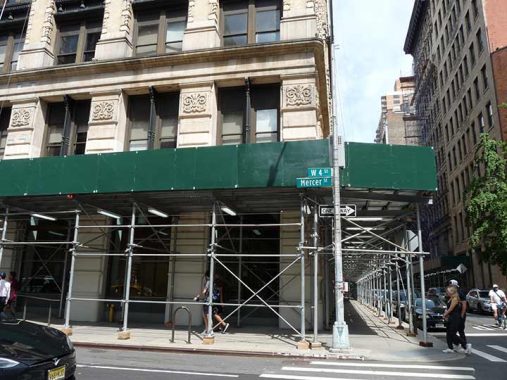
From 1974 to 2004 the ground floor at #15 West 4th Street at Mercer hosted rock club The Bottom Line, opened by Art Alan Pepper and Stanley Snadowsky. It helped launch the careers of such well-known names as Bruce Springsteen and mainstream rockers such as Pat Benatar and Hall and Oates played here along with punk/new wavers such as Patti Smith. The Ramones may have launched at nearby CBGB but they also played the Bottom Line. I have been a patron for such acts as Devo and Robyn Hitchcock, the latter more than once. The club seated 400 and had a no-smoking policy years before it was universally adopted during the Michael Bloomberg mayoralty. Seating was tables and chairs perpendicular to the stage and thus, you had to strain your neck a bit to see the performer.
One act here I didn’t catch but lined up for was Elvis Costello, who famously played three clubs in one night in lower Manhattan in April 1979: the Bottom Line and the equally shuttered Lone Star Cafe and Great Gildersleeves. The show sold out while I was on line.
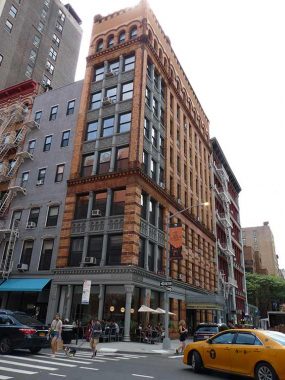
East of Mercer Street West 4th enters the NoHo Landmarked District, This building, wide along Mercer and narrow along West 4th, is a Romanesque manufacturing loft built in 1895.
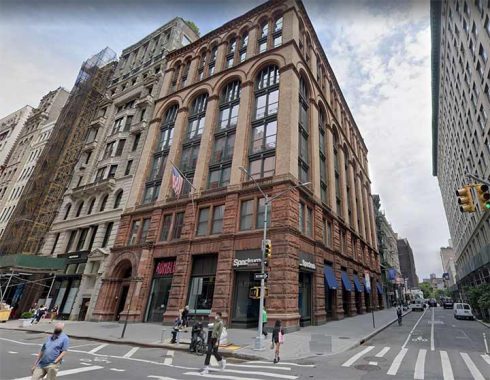
The 8-story building on the NE corner of Broadway and East 4th was designed by George Post and built in 1891, with its distinctive 2 stories of ashlar stone and large arched windows. In the 1990s it became headquarters of the National Audubon Society.
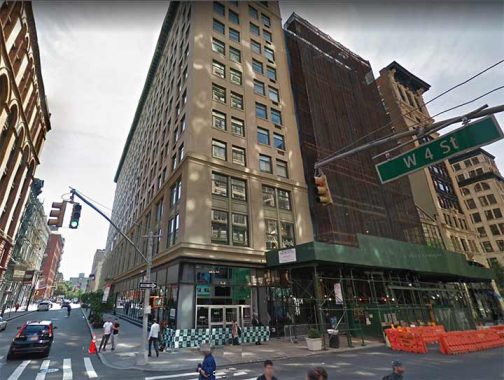
Across East 4th at #692-694 Broadway this 12-story loft went up in 1909. I frequented it often in the 1980s and 1990s when the bottom floor was tenanted by Tower Records, a NYC branch of the chain that originated in Los Angeles. One of my Sunday rituals, perhaps as often as once a month, was entering in the late afternoon and emerging in the evening with a stack of wax in one of Tower’s trademark yellow plastic bags.
More 4th Street coming soon…
As always, “comment…as you see fit.” I earn a small payment when you click on any ad on the site.
10/24/21

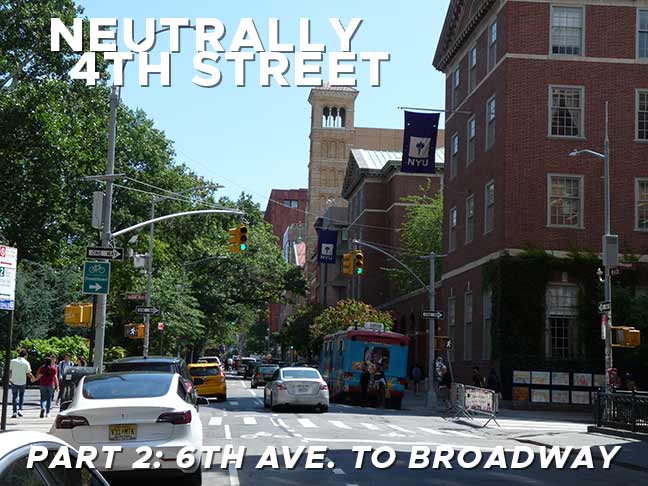
13 comments
It was Allan Pepper, not Art who co-owned the Bottom Line. I worked there for a couple of years in the 80s. He signed a bunch of my paychecks.
Pity the place is gone along with so many great music venues that will never be replaced.
Went to a banjo bar that was there prior to the Bottom Line whose name escapes me. It was corny but fun. Any help folks?
The reconfiguration of traffic on the avenues in Manhattan took place between 1951 and 1966. Madison and Fifth Avenues were the last to be reconfigured on January 14,
1966. Sixth Avenue was reconfigured to carry one-way traffic north of its intersection with Broadway in Herald Square on March 10, 1957. The rest of the avenue followed on November 10, 1963.
I know a place called Folk City was right acroos Mercer St back in the day.
There are a couple of excellent c.1930 Fairchild aerial photographs of Washington Sq Park and environs in NYPL Digital. We use an inset of one to display the route of the 6th Ave El.
The artist John Sloan painted a scene with the 6th Avenue El 1928 called “Sixth Avenue Elevated at Third Street”. It can be seen in an image search for the painting by that name.
Does anyone remember the bar The Red Witch on Washington sq. south?One of the so called
“dugout bars” because its entrance was below street level.
lavamap.com lists 37 Washington Square West as being built in 1929.
The King in Yellow by Robert Chambers (1895) is an unclassifiable book of short stories that are part fantasy, part historical fiction. Some take place on Washington Square. A “suicide parlor” is described as being at South Fifth Avenue and 4th Street. When I first read the book, coincidentally Bobst Library was having a problem with suicides and attempted suicides from students jumping from high floors in its atrium–the exact spot of Chambers’ fictional suicide parlor.
I was at that Elvis Costello show, bought the tickets in advance, early show, great memories. Thanks for the pics, great concerts at that club, I saw the opening night with Dr. John Feb 74, made the place my second home for the next 29 years!
I saw Laura Nyro there and never thought it would be the last time.
I used to budget a certain amount per month to spend at Tower records. Loved spending time there.
Tom – regarding the banjo bar, could you be thinking of My Father’s Moustache? It was on 10th and 7th Ave, see photo –
https://www.pinterest.com/pin/79587118389422640/
Is it true that 4th Street is the only numbered street in Manhattan longer than the avenue with the same number? (I do a lot of reading and can’t always remember where I find these tidbits.)
I never thought of that.